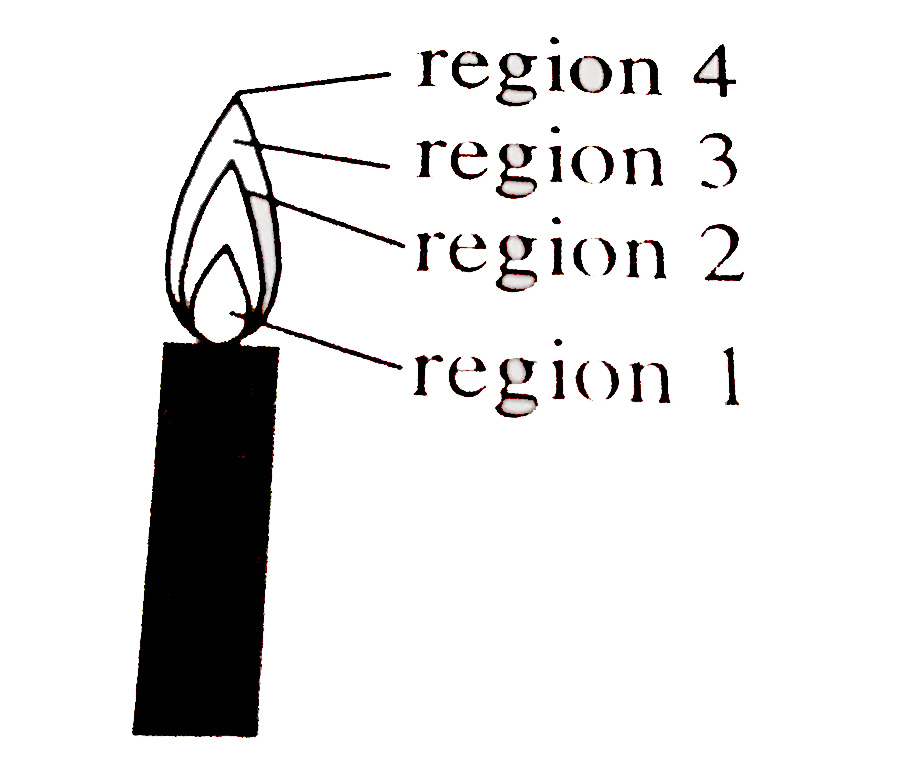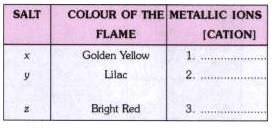The hottest part of the flame of a Bunsen burner is the
Blue Zone
Zone of complete combustion
Zone fo partial combustion
All parts of the flame are equally hot.
The correct Answer is:B
To determine the hottest part of the flame of a Bunsen burner, we can follow these steps:
1. Understand the Structure of the Flame: A Bunsen burner flame consists of different zones, each with varying temperatures. The main zones are the inner cone, outer cone, and the zone above the flame.
2. Identify the Zones:
- Inner Cone: This is the part of the flame that is closest to the burner. It is where the gas is initially ignited and is usually a yellowish color due to incomplete combustion.
- Outer Cone: Surrounding the inner cone, this area is where complete combustion occurs, and it appears blue. This zone is typically the hottest part of the flame.
- Zone Above the Flame: This area is where the gases are still burning and is cooler than the outer cone.
3. Determine the Temperature: The temperature in the outer cone can reach up to approximately 3500 degrees Celsius, which is significantly higher than the inner cone.
4. Conclusion: Based on the analysis of the zones, the hottest part of the flame of a Bunsen burner is the outer cone where complete combustion occurs.
5. Select the Correct Option: From the options provided, the correct answer is the outer cone, which is the zone of complete combustion.
Final Answer:
The hottest part of the flame of a Bunsen burner is the outer cone.
---
- Inner Cone: This is the part of the flame that is closest to the burner. It is where the gas is initially ignited and is usually a yellowish color due to incomplete combustion.
- Outer Cone: Surrounding the inner cone, this area is where complete combustion occurs, and it appears blue. This zone is typically the hottest part of the flame.
- Zone Above the Flame: This area is where the gases are still burning and is cooler than the outer cone.
The hottest part of the flame of a Bunsen burner is the outer cone.
Topper's Solved these Questions
- QUALITATIVE ANALYSIS (ANION)BOOK - RESONANCE ENGLISHCHAPTER - QUALITATIVE ANALYSIS (ANION)EXERCISE - Exercise-2
44 Videos
- QUALITATIVE ANALYSIS (ANION)BOOK - RESONANCE ENGLISHCHAPTER - QUALITATIVE ANALYSIS (ANION)EXERCISE - Exercise-3
10 Videos
- QUALITATIVE ANALYSIS (ANION)BOOK - RESONANCE ENGLISHCHAPTER - QUALITATIVE ANALYSIS (ANION)EXERCISE - Matching List Type
1 Videos
- QUALITATIVE ANALYSISBOOK - RESONANCE ENGLISHCHAPTER - QUALITATIVE ANALYSISEXERCISE - INORGANIC CHMISTRY(Qualitative analysis)
35 Videos
- QUALITATIVE ANALYSIS PART 1BOOK - RESONANCE ENGLISHCHAPTER - QUALITATIVE ANALYSIS PART 1EXERCISE - A.L.P
39 Videos
Similar Questions
The colour shown by potassium metal in the oxidizing flame of Bunsen burner is
View SolutionState with equations what happens when borax is heated on a platinum wire loop and to resulting transparent mass, a mixture amount of CuO is added and the mixture is again heated.
(a) First in the oxidising flame and
(b) Then in the reducing flame of a Bunsen burner ?
View SolutionThe hottest region of Bunsen flame shown in the figure below is :

View SolutionThe hottest region of Bunsen flame shown in the figure below is :

View SolutionA minute of cupric salt is heated on borax bead in reducing flame of bunsen burner, the colour of bead after cooling will be
View SolutionWhen borax bead containing a small amount of metal salt is heated in reducing flame of bunser burner, the colour of the bead after heating was blue . The metal present in the salt would be
View SolutionThe metallic ions (the cations) can be identify by performing flame test which is describe below.
"Make a paste of the given salt in concentrated hydrochloric acid. Load the paste on a clean platinum wire and introduce it in a non-luminous bunsen burner flame. Note the colour of the flame imparted by the flame. Tabulate your answer in the formate given below. The salt x imparts golden yellow flame. The salt y imparts lilac flame and the salt z imparts bright red flame.

View SolutionWhen a substance A reacts with water it produces a combustible gas B and a solution of substance C in water. When another substance D reacts with this solution of C, it also produces the same gas B on warming but D can produce gas B on reaction with dilute sulphuric acid at room temperature. A imparts a deep golden yellow colour a smokeless flame to Bunsen burner. A,B,C, and D respectively are :
View SolutionAlkanline earth metal nitrate (A) on heating decompose, leaving a solid residue (B) which goes into solution with dilute HCI. The solution of (B) gives a white precipitate (C) is dissolved in dilute HCl and the solution is treated with potassium chromae to get yellow precipitate (D). The solution (B) with dilute H2SO4 also gives a white precipitate (E) insoluble in diute HCl and nitric acid. the precipitate (E) is a part of a white pigment lithopone.
The nitrate (A) can be confirmed by flame test. The colour imparted by the salt to the Bunsen flame is
View SolutionAssertion Green edge flame rest tells presence of borate ion.
Reason: Green colour of the flame is due to burining of tri ethyl borate.
View Solution
